RRD ran rampant in my yard - Need advice
Hi folks
Late in 2019 and into 2020 I was posting about a dozen roses that I took out from RRD and another dozen I was concerned about. The latter didn't show enough tell-tale signs of Rose Rosette Disease (RRD) in our discussions so I left them to watch them. I was however concerned as the roses I took out were all over different sites in my yard, so I pruned all the remaining roses down to the ground as a precaution (a massive task as I had over 900 roses at the time).
I suspect that pruning all those roses in a short period of time with RRD in my yard was an official Very Bad Idea. I had to prune massive growth in less than a month in the fall and I didn't sanitize my pruners as I went, as I could barely stagger from one rose to another. I think in that process I spread the RRD to the rest of my roses and they took a while to incubate the disease and show some signs.
Over 2021 and 2022 I saw what I considered "odd" growth but not enough to be concerned about. In particular, in spring 2022 quite a few roses showed "tufty" growth with multiple canes growing out of a single nodule but they seemed to grow out of it as spring progressed. During that time none of them showed the classic witch's broom growth or gnarled canes or abnormal redness of canes. However quite a few roses dwindled in odd ways and several had burnt looking foliage and uncharacteristically scrawny growth (including Jack's Wish that I had been concerned about).
For instance, Sunrise Sunset was a massive well established hardy 14' climber at the end of 2021 and by June 2022 the canes had withered to a few pipe cleaner sized canes and scrawny attempts at blooms on a few other canes. It was one of the roses where I'd noticed one tuft - one stinkin' tuft - when I did my massive pruning in 2020 but it showed no other signs that I could tell all of 2021. For me, I've sadly noticed that this kind of tufty growth is an early sign of what would be more evident as RRD. I'm not posting pictures of this because I don't want to scare rose newbies from this atypical presentation of RRD that doesn't look like the normal progressions - most of you haven't had RRD run rampant and we should stick to the typical symptoms.
By fall of 2022 I was seeing problematic growth EVERYWHERE. I marked at least 75 roses as RRD? in my notes but there wasn't time to remove all of them before the snow flew. By spring this year I saw that wretched awful tufty growth on everything. Not all of them had yet progressed to classic RRD signs - in fact, only Darlow's Enigma (that I'd been concerned about in 2020) and another handful of 10 or so roses were unmistakably showing classic signs - but I'd watched the progression for two years to realize the inevitable was going to happen.
So in March 2023 this year, I dug out every rose in my yard. Every. Single. Rose. 850 of them. I just didn't see a choice any more and the few roses that didn't show any signs yet (like Grandmother's Hat) weren't rare enough to risk them being Typhoid Mary for another ongoing wave of RRD. Quadra had a root ball the size of those exercise balls you sit on and my husband had to take an axe to the roots.
This was obviously devastating, physically and emotionally. I have totally stalled in letting you all know on GardenWeb because somehow it made it more real and I didn't want to face that. You're my rose community and I'm still part of it.
So I'm asking three things of you in response to all this if you're willing:
1. Cry with me. I've told friends and family and they're sympathetic but they don't get it the way you do. Even my local rose society that is full of very sweet people were more puzzled than anything. My analogy is that it's like running a huge no-kill pet shelter for 15 years and then having rabies sweep the shelter and you have to be the one to personally kill every one of them. Yes, I can get another Grandmother's Hat like I could get another Golden Lab, but it's not the same rose "pet" I've loved all those years.
2. Advise me about when I can replant. It has now been 3 months since I dug out all my roses (except for some stray suckers and a few stalwart survivors from root tips) and I recall from conversations with Rachel at Palatine that it's safe to replant after RRD after 1-2 months. I'd like confirmation from those of you who've replanted after RRD, particularly StillAnn if she sees this. I already had my usual order of 150 or so roses that I've quarantined behind a makeshift "hut" starting in mid-April to stop any wind transmission from the yard because the mites would be left in the leaf mulch until they...die? Fade? How long does that take is a key question. I know you can transmit RRD with clothes and tools and that has to include mulch. After a long conversation with myself (and my husband) I realize that roses are part of who I am and worth the heartache of trying again.
3. Keep an eye out for some of my irreplaceable or rare roses. I'm very glad that I sent cuttings of some of my uncommon roses various places and some of them are in commerce now (like my Edgar Degas that went to Long Ago Roses and then Roses Unlimited). I counted and only about 40 of my roses were irreplaceable as far as I can tell, given assumptions that Palatine and other vendors will return to offering roses that aren't on their current lists. I'll make a separate wish list post of roses I'm really crying over and would love a heads-up if you see them offered anywhere.
Thanks for listening. Out to check my rose ghetto and wait to plant soon (I hope)
Cynthia
Comments (84)
oursteelers 8B PNW
9 months agoI juat saw this. Cynthia, I am so very sorry you are going through this. No words. Just so much sympathy.
nippstress - zone 5 Nebraska thanked oursteelers 8B PNWmark_roeder 4B NE Iowa
9 months agoCynthia, I had read your posts, but now just looked at the photos. Ten to twelve years ago, I thought my roses were at the apex with just the right mix, and then I was shoveling with RRD. It hurt. But, in time my rose beds now are darn close to the same quality if not better. The first flush this spring was amazing.
In another year you will be back on track. But you had so many roses. I have 38, and that's as many as I can manage.nippstress - zone 5 Nebraska thanked mark_roeder 4B NE IowaRelated Professionals
Danbury Landscape Architects & Landscape Designers · Barrington Landscape Contractors · Bridgeport Landscape Contractors · Caldwell Landscape Contractors · Costa Mesa Landscape Contractors · Gloucester Landscape Contractors · Marlborough Landscape Contractors · Colorado Springs Siding & Exteriors · Massapequa Siding & Exteriors · Glassmanor Landscape Architects & Landscape Designers · Middle River Landscape Architects & Landscape Designers · Saint Charles Landscape Architects & Landscape Designers · Tomball Landscape Architects & Landscape Designers · Crystal Landscape Contractors · Plymouth Landscape Contractorsnippstress - zone 5 Nebraska
Original Author9 months agoThank you so much for your heartfelt words of sympathy Bart Bart, Oursteelers. Sometimes there aren't words but your kindness shines through regardless. I appreciate the word Immane from Melissa and there is a lot of work ahead, though sometimes that is what we sign up for as rose gardeners, or more accurately Big G Rose Gardeners. I'm grateful for your confidence in my ability to start over and create something again Melissa , Ingrid and MMMM. I actually think I've learned a lot since I put in my garden 18 years ago and I can correct a lot of mistakes this time around (starting with NO Fimbriata ever again).
Kristine I do love Prairie Sunrise and it was one of my cold side survivors on the north side of my house for 15 years or so. It's definitely on the replacement list. I appreciate the lily compliment - they are undemanding and a welcome dose of color these days.
Frances thanks for the offer to root something if available for me. I'll post another thread with a wish list within a couple of days.
Ingrid and Rosecanadian the virtual hugs and tears are like a cooling rain on a thirsty garden. Sharing pain makes it better and I appreciate you and everyone chiming in with me. You're right that it was one after another after another. In some ways it was less traumatic to simply reach the point where they all have to go rather than facing a new death every time I discovered RRD in a new rose. It was a mechanical (and bleak) process that took plenty of emotional fortitude indeed. I like the analogy of a bleached coral reef with all the color gone but at least it is able to be recovered as opposed to our actual coral reefs that have bleaker prospects in the face of environmental change and pollution.
For me, now I get to decide which roses I truly love and perhaps limit how much I try "maybe it'll be nice" roses. Coming back up from the bottom is a hopeful process and maybe I'll even design the beds on purpose or not plant them too close together this time around. I've learned that roses can indeed grow big in Nebraska so I'm hoping I can have the resolve to stick to fewer and better roses.
Thanks for everyone's support! Your messages have been like the fresh homemade cinnamon rolls my neighbor brought over for my birthday - warm, sweet, kind, and the best thing I could ask for.
Cynthiarosecanadian
9 months agoAwwww...Cynthia...that is such a kind thing to say..like homemade cinnamon rolls. :) :) I'm glad you still have your hope and can imagine starting again. That's wonderful. I am really proud of you!
nippstress - zone 5 Nebraska thanked rosecanadianUser
9 months agoAll I can say is this: if I were to find myself in your shoes, I'd remove all the roses and find some other genus to cultivate, and try not to mourn the loss.
nippstress - zone 5 Nebraska thanked Userjacqueline9CA
9 months agoCynthia - so sad and so horrifying. I had trouble reading through this thread because my eyes kept tearing up and I could not see to read - I think I went through half a new box of Kleenex. You are very brave, and I can only imagine how you feel. The good part, of course, is all of the love and support everyone is sending back your way.
Please do post a list of any rare roses you lost which you want to find sources for - who knows what might be lurking in someone's garden which is not commercially available.
With love and hugs -
Jackienippstress - zone 5 Nebraska thanked jacqueline9CA- nippstress - zone 5 Nebraska thanked jim1961 / Central Pennsylvania / Zone 6
forever_a_newbie_VA8
9 months agoIt is heartbreaking reading this post, Cynthia. At the same time I am deeply moved at your bravery. Best of wishes to your effort and success!
nippstress - zone 5 Nebraska thanked forever_a_newbie_VA8charles kidder
9 months agoHorrible. I lose roses every now and then from RRD, but nothing like that. I keep a vigilant eye and yank them right away. I've also learned to not plant roses in mass plantings. You need to mix them in with perennials. Space them out.
Eventually RRD resistant roses will happen. It just takes a mutation or two and someone smart enough to propagate. Someone could make a fortune if it blooms half decently. Probably not in my life, but pretty sure it will materialize.nippstress - zone 5 Nebraska thanked charles kidderSam CO z5
9 months agoI dont post much on here, but I have scoured through many of your posts to learn about how certain roses do, as I am im colorado and have a similarly difficult climate. I am happy to send cuttings of anything i have that you are interested in, including edgar degas (that i got due to you!) i am so incredibly sorry for what you are going through. i cant even begin to imagine the heartbreak.
nippstress - zone 5 Nebraska thanked Sam CO z5nippstress - zone 5 Nebraska
Original Author9 months agoThanks again everyone for the heartfelt and sympathetic responses. The virtual hugs and prayers are welcome Jim. I don't know how brave I am in reality Forever A newbie (and Jacqueline, RoseCanadian) because it's just something forced on me that I had to respond to. Braveness would be helping a friend dig out their RRD roses but after all this I'd be a bit gun shy. Well, I will help a neighbor dig out some that look rather suspicious but that's self preservation so it's not really brave.
Jacqueline thanks for sacrificing half a box of Kleenex in sympathy. I spent my share of Kleenex on you with your stories of digging out 100 year old or older roses because of the fire hazards in your area. My roses were no more than 15 years old so most of them are at least theoretically replaceable, and thanks to the kind offers from folks I may find access to some of those yet. Irreplaceable was what happened to Beth in California and the horrible fires, where she lost not only 1000+ largely unique roses but also her house and property. None of what I'm going through begins to compare to that.
Paul - I agree with you that the sensible thing to do would be to give up on roses. I spent several months pondering it but part of the reason we post here on Garden web Roses is that we're not entirely sensible. I mean, what part of 850 roses in a modestly large suburban yard sounds sensible to you? I look at my garden now without roses, and not only is it less exciting, the challenge is mostly gone. For me the heartache is worth it for the challenges and joys. You've had your share of rose heartache with closing Uncommon Rose as well as losing access to your own bred rose "children", so you have far more cause for complaint in the long run. Apologies that I can't help recover more of those roses you bred to return to circulation other than what I'd already sent to Mindy at Hummingbird. Most of my gallicas as well as albas and damasks were relatively less early or obviously affected by RRD but Marianne and Song of the Stars must have been in the circulation (or drop) path as they showed the decline starting last fall.
Kidhorn2 - I appreciate the advice and I have the opportunity now that the roses are out to re-examine the whole garden and the place of roses in it. As you can see from the lily picture above I have plenty of other mixed perennials in the garden (and daylilies and phlox and any number of other perennials in the other beds), though I will admit to planting everything rather too close together. A little more space between everything would be sensible (though sensible is a relative term with me). As much as I love roses I don't want a monoculture. There would be bleak days in the Japanese Beetle seasons if I had one. Speaking of which, I haven't seen one Japanese Beetle this year after being overrun with them last year. See, another "bright" side of digging out roses (not to mention exceptional drought).
Sam, I'm honored that you found my posts useful in making decisions about roses for your yard in Colorado. I can also learn from roses that do well for you, as you are more likely to have consistent snow cover that we lack and can grow roses that are marginal for me. Matt at High Country Roses lists some roses he grows just fine that aren't nearly as robust for me. Isn't Edgar Degas a wonderful rose though? I appreciate the offer of cuttings but since the children and grandchildren of my original plant are at Long Ago Roses and Roses Unlimited I'll work with those vendors to bring him back to my yard. I'll have a long list of replacement roses from each place anyway, assuming I can clear my yard for rose occupancy with input from Ann.
Your response Ann to these RRD issues is so incredibly welcome and useful I'll do a separate post to reply to your points. Thank you thank you thank you!!Cynthia
rosecanadian
9 months agoCynthia - definition of bravery: the quality or state of having or showing mental or moral strength to face danger, fear, or difficulty. Doesn't that sound like you? :)
nippstress - zone 5 Nebraska thanked rosecanadiannippstress - zone 5 Nebraska
Original Author9 months agoAnn, I am so grateful that you're willing to take the time and share your expertise with us on this issue. I read entirely through the RRD blog series you posted back in 2019-20 when I first was dealing with this and you always have clear and highly pertinent information. Apologies to everyone else on GW if I go all "rose geek" for a bit in whatever conversations Ann is willing to tolerate with me. Let me know if I ought to start a separate thread or communicate offline with Ann (again, assuming she is willing). I figure this information is a service to the international rose community on GW though and we all benefit from what she has to share. In the case of RRD, our only weapon is knowledge so I'm looking to understand the process as well as possible as my best defense.
1. It is really wonderful to hear that I probably didn't directly cause the spread of RRD throughout my yard because of pruning everything back in 2020. That helps reduce a lot of guilt and feeling stupid to boot. It also relieves a ton of guilt because as I was digging out all my roses this spring I learned that our local legacy rose garden came down with significant spread of RRD this spring too. Annnnnd last spring was the first year I volunteered to help prune in that garden. It's bad enough to experience RRD rampant in my own yard, but it would be way worse to be the cause of sharing it with an entire community and huge rose garden for the whole city. It's fascinating that the master's thesis student couldn't get RRD to spread deliberately by pruning. I presume the same applies to clothing, buckets, and leaf debris too?
2. I appreciate the urgency of checking my neighborhood for a source of the spreading infection. Being in the middle of suburbia there isn't any patch of wild roses within at least 2-3 miles and even on the walking trails to the east of us I haven't seen any multiflora or other wild roses. There are corporate plantings several lots to the west which would be the prevailing direction of wind to me, but all I've ever noticed in those beds are the boring and ubiquitous combination of red barberry, lime green bush (spirea maybe?) and Stella D'Oro daylilies that is all over town. I've not seen the kinds of rampant corporate RRD that Ben has commented on, but I'll take a more detailed walk and check later this week when I can get off during daylight hours. As for neighbors, I pointed out some subtle RRD signs in about 6-8 widely spaced roses in my neighbor to the west but they were much less advanced than in my yard so I find it hard to see those as the source. Similarly a neighbor kitty corner to my southeast backyard has two fence lines of widely spaced knockouts but I checked them over the fence last night and only spotted one or two that had suspicious looking slightly larger canes growing out of smaller ones, again less dramatic than most of my affected roses. Another neighbor across the street had one small infected rose that she has dug out but the wind patterns weren't right to affect my entire yard. By far the nastiest case of RRD was the original Robin Hood dug out in 2020 that I'd planted at my neighbor's directly to my east and it still seems that is the most likely source of the chain reactions in the rest of my yard.
3. You are right that I should be avoiding the potential for nasty little surprises of root pieces turning into infected rose shoots and wait till next spring to plant. A majority of my roses were own root and relatively young, but the best established and biggest were more likely to be grafted, almost all Dr. Huey or multiflora (?) that Palatine uses. Your comment that "rose roots will root graft to other plants" I presume is referring to root grafting onto other roses, not other species like phlox or daylilies? Again, that is the benefit of clarity in digging out anything that is a rose anywhere in my yard - if a rose is sprouting in any bed it's not supposed to be there and it gets Roundup sprayed to kill it down to the roots - repeatedly as needed all season.
4. Thanks for the input about air flow patterns and particularly the mite drop patterns. I'll sketch out a diagram of my yard and prevalent trees or other structures, of which I only have a few. Some of the least affected roses were under the spread of my biggest tree, a 20' Burr Oak. There's a pine too but almost no roses under that. The neighbors behind me have some tall bushy shrubs and small trees along our shared fence but none of them overhang into my yard. The neighbors to the east with the Robin Hood first offender had it under another large Burr Oak and the roses along that shared fence were the climbers in my photos above that were pretty consistently affected. However, in between Robin Hood and my other most affected rose (Darlow's Enigma) was a massive 8' spread along the fence of The Bishop and I could not find one single tuft this March on him even though he was refereeing between two RRD thugs for several years and in the drop zone of the neighbor's Burr Oak. I don't see any pattern of the first or most significant roses affected that follow these drop zones, but I'd love your input when I can get this drawn in another day or two.
5. Are there different strains of RRD like there are of blackspot? If so, could these patterns be different regionally about how it is spread? I learned from your materials that the first identification of RRD back in the 50's or so was in Nebraska (oh joy). Could it be possible that Nebraska is also the reluctant epicenter of a new strain of RRD? Not that I remotely want there to be new variants of this scourge or heaven forbid have it be named Nebraska RRD (or worse, Nippstress RRD). Still, it's worth asking since the progression of symptoms didn't seem to follow the patterns and pictures you showed in your materials.
Thanks again and I'll post an update with a chart after I can do a neighborhood walk too. This is incredibly helpful
Cynthiastillanntn6b
9 months agoI think we should keep talking here. It's the best way to learn from each other.
I'll write more later but this is something I learned from a friend who lived in a fairly narrow valley. Lovely gardens, they had taken out a huge tree and had a spring emerge. Just up from that spring she built an arch and trained a rose up and over it. (And lovely perennials at the base.) And she saw RRD out on the end of one of the cane that had grown up across and over. The RRD was on one cane draped over. She decided to remove the rose and replanted there a year later. Great rose growing conditions (rose loved the water nearby) and darned if it didn't get RRD out on one cane .....that was in the same draped over location as the first. For me, that was sickening as it was for her. It was also a learning experience.
One of my best ideas was a bed of as many Orleans Rose related polyanthas that I could collect. It was coming along magnficently. And then two on the northeasten up slope end got RRD. I took them out. Replanted. Re RRDed the same place. I don't think it came from roots left, the plants were not that large. But as I removed problems, others that weren't adjacent were getting sick. Where the wind came whipping around from the pass between House Mountain and Clinch Mountain. And hit an arch we had built that slowed it down just enough.
First garden locally we visited that had RRD. Roses all around the house. Only place roses hadn't gotten RRD was a narrow bed, next to the driveway very close to the neighbor's house. Lake front houses with wind tunnel like conditions between the houses. And winds speed up in wind tunnels and don't drop mites there.
'Nuff for now.Ann
nippstress - zone 5 Nebraska thanked stillanntn6bstillanntn6b
9 months agoAbout 'strains' of RRD.
Several years ago I was actively talking with the scientists at U Arkansas who were the ones who defined RRD as a virus. At their request I collected RRD samples from a number of states in and around Tennessee, froze them and sent them still frozen with dry ice by Fedex to them. Their analyses showed and they published that they only found one kind of RRD in all the samples they ran.
The virus group (probably not the best word) RRD belongs to is Emaravirus European Mountain Ash Ringspot virus. That was the first of its group.
A paper from China reported RRD in a bed of hybrid teas in a public garden based on the symptoms. But in that garden was a Pawlonia tree with a rosette producing virus. (Pawlonias are the trees that have beautiful purple flowers and that line I-40 through the Smokies. I haven't seen anything bad on them.) But I would guess that the roots from the Chinese pawlonia sought out the improved soil and irrigation of that rose bed and gave the roses something in return. I don't think any followups have been done on that.
A variable that hasn't been studied is what happens when RRD infects a rose that is already living with some of the rose viruses that are common. I've seen a huge range in symptoms on Knockouts, and I don't know if it's soil variations, or cultivar differences that have happened with the production of tens of thousands of he same rose.
Something really strange: roses go dormant in winter. Even roses with RRD. Towards the end of their lives, when there are lots of symptoms on the dormant bush, sometimes the rose will send out a long cane with leaves, when none of the canes -sick or otherwise- are putting out leaves. Just one cane that (in the ones I watched) that was longer than the other canes on the bush. After a couple of weeks, cold would kill it.
Which brings up the color of dead rose canes. When my roses' canes die of old age, they die gray. Often when RRD canes die, their color is black. Someday I'm going to be very bored and go and research the pigments in canes and the sequence that they follow.
Ann (cooking a version of Maurice's pork hash this afternoon.)nippstress - zone 5 Nebraska thanked stillanntn6brosesmi5a
9 months agoAn article in the latest issue of the American Horticulture society, "Taming America's Wild Roses" written by Jule Bawden-Davis, mentioned that researchers are looking at how several native roses seem to be resistant to RRD, and they are hoping to use the natives genetics to improve our typical garden roses which are mostly based on non-native genetics. See https://ahsgardening.org/gardening-resources/gardening-publications/the-american-gardener/issue/july-august-2023/
I noticed here that when RRD rampaged through our county, all of our local multiflora roses which usually grow in the thickets along the road were totally wiped out. In my garden areas, the most dramatic losses were on the fringes. For example, where I had a 15' row of an alba rose that I had let sucker freely, all of the alba died out quickly in just a few months, before I knew what I was dealing with, but the R. setigera, growing in its ~20' row, remained a picture of health, covered with its soft, almost hairy leaves; it never blinked. It has never shown any signs of infection.
Within the garden proper, I lost some roses, and continue to lose an average of one or two roses a year, all in certain defined areas. I noticed too, that the multifloras are back along the roadsides, and I even found a large healthy one growing in the back of the orchard this spring.
Of the native roses, I grow Rosa setigera, R. virginiana, and R. palutris. None have ever shown any sign of infection , and both R. setigera and R. virginiana cover quite a large area -- the R. virginiana has rambled through over 200' in the meadow garden. R. palutris is a lovely full bush about 8' high and wide -- beautiful foliage, and almost thorn free. R. palutris especially is a rose I wish hybridizers would utilize -- no blackspot (none of the natives get it), fragrant, and lovely bush form.
Hmm, now that I think about it, the rose 'Baltimore Belle' is a R. setigera hybrid, and it grows in two places in my garden -- very healthy, one long blooming period -- lovely.
I tried 'Long John Silver, another R. Setigera hybrid, but culled it because it just wanted to grow 12' long octopus arms and only gave a handful of flowers each year.nippstress - zone 5 Nebraska thanked rosesmi5anippstress - zone 5 Nebraska
Original Author9 months agoBelated thanks to Mark with the encouragement that my rose garden can return from this, assuming I can beat RRD. I have a lot of roses in my rose ghetto waiting to prove you right next spring!
Very well, I concede the bravery, Rosecanadian, in respect to your savvy dictionary quote. I've seen a simpler definition of bravery that is "being afraid of something but doing it anyway". I would agree that this applies in my present situation.
Rosesmi5a it's interesting that your species roses seem to be more resilient. I found that my gallicas and albas and other once bloomers were among the few roses not specifically affected. Geschwind's Nordlandsrose was climbing on an arch and a prime candidate for mite drop as Ann talks about, but I found nary a sign on it, though it's gone with the rest as well. I don't have any species roses to compare though.
Sorry for the delay in responding Ann, but I had to find enough relatively cool days this weekend to finish scouring the neighborhood for RRD. I wove in and out of all the neighbors behind me for two streets covering several blocks each way, and I already knew there wasn't any remaining in the regions in front of my house for several blocks. I'll post a few pictures here and see how many Houzz lets me attach to the same response.
Most of the neglected roses I found in yards here and there looked like this - classic Rose Mosaic Virus and probably Dr. Huey, but nothing that looks like RRD to me: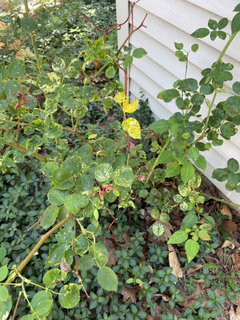
Here's another neglected probable HT that looks fine: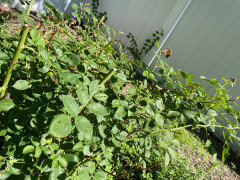
nippstress - zone 5 Nebraska
Original Author9 months agoHere are some more from the neighbor directly behind me (to the south) that are a bit neglected but don't look like RRD to me:
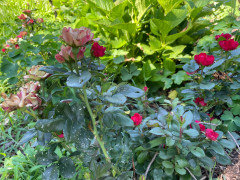
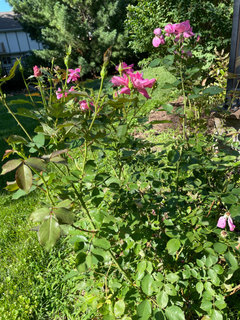
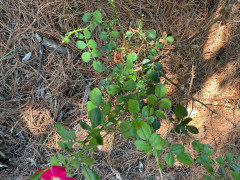
nippstress - zone 5 Nebraska
Original Author9 months agoHere are the roses at the neighbor's to the southeast of me (east of the neighbor above) that have RRD, at least the first two. I would welcome a judgment of the other two because these are the ones that have sentimental value for the owner. If they all have RRD, I'll post pictures of the rest of them. These are the only ones that looked at all problematic to me, but not nearly as bad as the original Robin Hood in the neighbor to the north of them (due east of me). That makes these knockouts the victims rather than perpetrators it would seem.
Clear RRD with two fatter thorny canes from a lesser cane: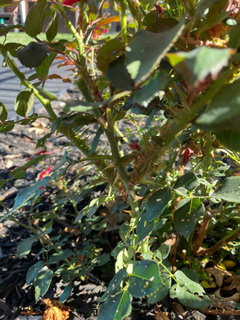
Not sure about the next one but I don't like the thorniness of the bottom dead flower to the bottom left of teh picture, and the growth looks a little dense toward the top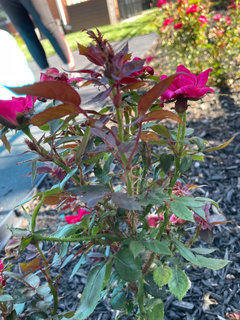
This one doesn't scream RRD either but I don't like the pattern of thorniness on the whole right side of this shot that isn't matched on the left side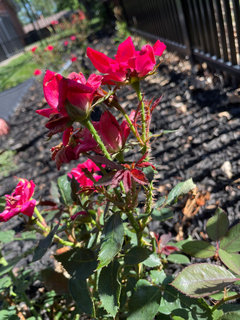
Not confident about this one either way. It looks like too many shoots branching from one site leading to the red shoots.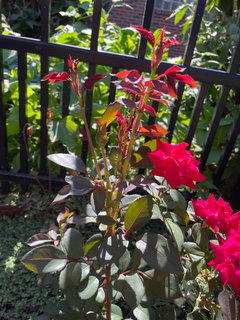
nippstress - zone 5 Nebraska
Original Author9 months agoSo the previous shot has some clear RRD but it's to the southeast with prevailing winds from the west. There are trees and arches in between to catch the mites for drop, but the wind is going the wrong way.
A few blocks to the west of me is a professional park with all kinds of plantings. 90% of these are harmless hydrangeas, salvias, native grasses, geraniums and other essentially tasteful arrangements. There are two areas with roses planted none of which scream RRD at me, and they look less problematic than any of the photos in the previous shot.
Here is the first area with something that doesn't look like knockouts- maybe Carefree Beauty or something similar? They look fine to me: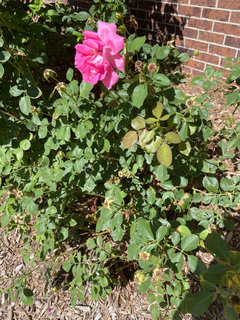
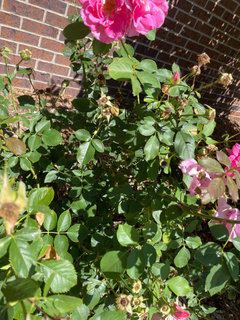
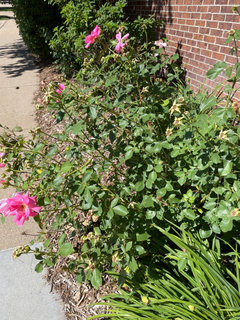
nippstress - zone 5 Nebraska
Original Author9 months agoThen there is another bank of roses that face west (i.e. not on a direct wind path toward my neighborhood) - these look like Knockout types. They have a sad need of deadheading but nothing jumps out at me to say RRD. They're well spaced out from each other and there's not much of an overhang though I suppose the building itself could be enough of an excuse for mite drop.
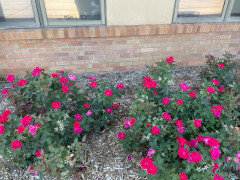
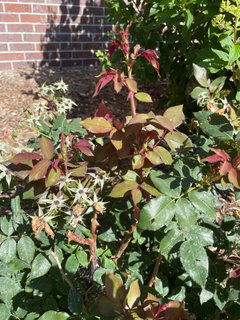
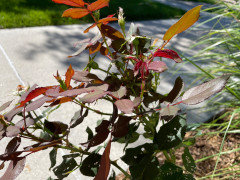
Not wild about the look of these but it still isn't a clear cut issue either way for me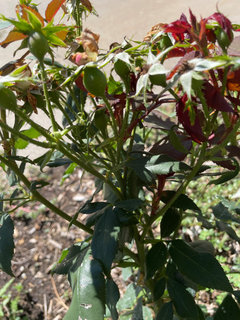
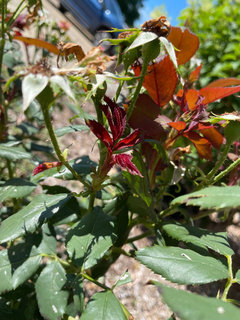
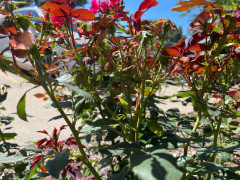
nippstress - zone 5 Nebraska
Original Author9 months agoThere are banks of these - about 12 plants, and some of them look better than others:
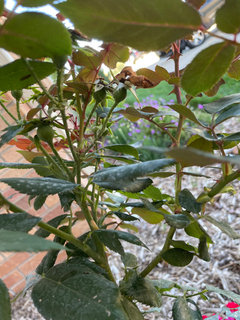
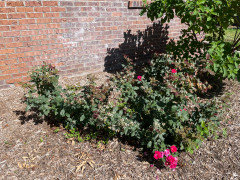
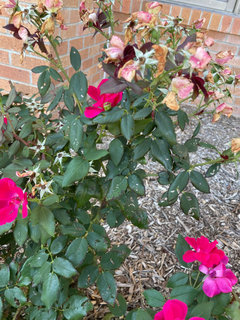
Here's the overhang that's the only place where upward movement would be happening - there aren't trees in this corporate park other than the scrawny type seen here: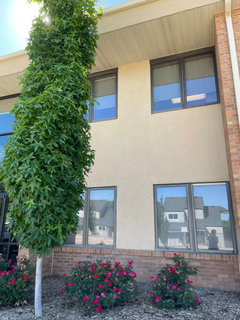
To get to me however, they'd have to snake around from this west facing view through a north corridor of nothing but cement:
Then cross a parking lot: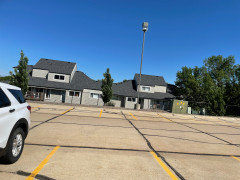
Then hook to the south past a long field to the southeast where you can just barely see my north neighbor's back yard: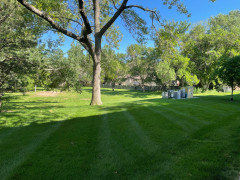
Sheila z8a Rogue Valley OR
9 months agoThat is heartening that there are also healthy roses and space around you too, Cynthia. I hope the RRD afflicted do get removed quickly.
nippstress - zone 5 Nebraska thanked Sheila z8a Rogue Valley ORmad_gallica (z5 Eastern NY)
9 months agoFWIW, this is my experience with RRD.
Where I live, very few people grow roses. Very, very few. Most of the undeveloped land is woods that are shady enough that multiflora doesn't grow there. Where multiflora does grow is on the roadsides.
During the summer, the primary wind direction is from the west. During the winter, it varies, but the severe storms come from the northeast. The closest I've seen infected multiflora is at least half a mile to the northeast. Given where roses have gotten infected in my yard, it does seem to be coming from that direction. Which isn't at all what I expected. It is also coming from further away than expected. I've never had two roses anywhere near each other get infected aside from some feral multiflora. Chloris did not get it from Jacques Cartier, even though it was practically suckering from JC's crown. John Cabot did not get it from Seafoam.
Everything you've said so far makes it sound like there is a major source of infection that you haven't found yet. It is probably farther away than you think, and may be in any direction. One of the advantages to living here is that symptomatic multiflora cannot survive a normal winter. So I don't have to rely on human intervention to remove them.
nippstress - zone 5 Nebraska thanked mad_gallica (z5 Eastern NY)Steve_M in PA
9 months ago@nippstress - So sorry to see the damage that was inflicted on your beautiful garden. That's rough! You seem to be handling it about as well as anyone could.
About your neighbor's roses - I think at least 3 of the 4 are doomed. The rose in the 4th photo might be OK, but I wouldn't count on it.
As for the corporate park, I agree that most of those roses look OK, but I think the ones you are "not wild about" look a little suspicious to me too.
It's a little hard to gauge the wind patterns, but those corporate roses may be victims more than spreaders of the virus, based on being so close to the opposite wall of that building. (If I understood the directions correctly.)
If you are serious about plotting out the spread, it may be time to consider making a map of the good and bad roses you have found, and the key windbreaks. You could use Google Earth Pro to add markers if you have a Windows PC. https://www.google.com/earth/versions/nippstress - zone 5 Nebraska thanked Steve_M in PArosecanadian
9 months agoCynthia - that is good to hear that resistance may be bred into our roses. Amen to that.
nippstress - zone 5 Nebraska thanked rosecanadiannippstress - zone 5 Nebraska
Original Author9 months agoThanks for the encouragement that there are healthy roses around Sheila - even directly behind me the neighbor's neglected roses look just fine. I agree that more disease resistant roses would be welcome RoseCanadian though it won't help our beloved OGRs that we want to maintain.
MadGallica, good to hear from you and you're another cold zone gardener who loves OGRs. I know there must be some multiflora somewhere in Nebraska but I just don't see it anywhere in the fields, roadsides, neglected neighborhoods, railroad corridor paths where we walk and bike. If there are neglected roses, they're almost always Dr. Huey and so far all the Dr Hueys in the neighborhood look fine. I agree that the infection could be coming from farther off, but I simply haven't seen anything problematic within about a mile radius. If it's further than a mile, I get a sense of hopelessness that this RRD could be coming from anywhere. Of course that's always true, but I just can't find any hotbeds of RRD outside of the community rose garden that is easily 5 miles to the east. RRD can happen any time anywhere, but I don't see the kind of RRD in fields that you describe or the rampant RRD in any direction that BenT describes. The maps I'll show below are all that I can find in a reasonable area.
Steve thanks for the feedback about the southeast neighbor's knockouts. I agree looking back at the pictures that the pictured ones have to go, and I'll take pictures of the rest of them to post here as soon as I can get back in touch with her. Ah, Google Earth, what a good idea! I don't have a PC but I found a Google map of my neighborhood and went back to the corporate park to find exactly where the bank of corporate Knockouts are relative to me. Closer than I'd realized as it seems, but I agree with you that at worst they look iffy, and some of them look fine.
I'll post those diagrams below and I welcome feedback about source and progression of infection in my yard.
Thanks everyone for your help! Ann, I'll respond separately to your very informative posts about mite drop and spread and variation in RRD symptoms after I post those maps.
Cynthianippstress - zone 5 Nebraska
Original Author9 months agoHere is a Google map of my neighborhood, with the street names blacked out because it's not a good idea to broadcast your exact address on a forum, though I love and trust the community here. I've marked my house, and labeled neighbors A through E around me that have (or had) roses. The top of the map is due north and the corporate park is to the west, with prevailing winds (lots of them in Nebraska) from the west to east.
Neighbor C is the one with the horrible Robin Hood that I planted but missed signs of RRD for at least a year or two before we removed it in 2020. Neighbor A had 3-4 RRD roses she took out on the west side of her house (2021-3) and has a new Knockout by her mailbox and another one at the NW corner of the house that look fine. Neighbor B had roses in the places marked with X that all had the tufty growth that mine did this spring. She took all of them out. Neighbor D is the one with the neglected roses I pictured above that look fine. Neighbor E has the bank of Knockouts with RRD that all look suspicious that I marked with X and more of them on the black lines I need to post for input.
The corporate plantings of Knockouts I posted photos above all came from the building with the blue teardrop marker to the west - I marked KO and a bank of circles. Those are roses I pictured above that some look fine and some a bit iffy, but it's not a hot mess. I marked one rose further to the west with CB (I'm calling it Carefree Beauty till I get a better name) and there are more CBs on the west side of that building outside of the map. All those look absolutely fine to me, and there are sample photos of these above.
So in terms of wind drift, if the corporate Knockouts are in fact the source of the problem the pattern could be wind past neighbor A across the circle to my front yard and down my side yards, including down my east side to neighbor C and the offending Robin Hood I marked with RH. There are mature trees all along the east side of the corporate park and in the neighborhood, but it's not quite as dense as the map makes it look. My backyard has a lot of shadows directly behind the house but I only have two trees in my backyard and behind the house is direct hot sun.
I'll post my own yard in the next commentCynthia
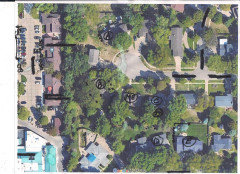
nippstress - zone 5 Nebraska
Original Author9 months agoHere's a rough (very rough) sketch of my yard and the pattern of RRD identification as far as I can recall. The map isn't to scale because we actually have a wedge-shaped back yard and it's beyond my visual skills to represent it accurately. All of beds 5 and 6 for instance are directly behind the house except for a bit on the west side of 5, but the map doesn't look that way. I marked large trees and bushes with circles and kept having to expand our 20' Burr Oak to represent the drip line of the branches. It extends a bit more into bed 10 but I stopped. Anywhere there are hatched lines there were no roses, but assume anything in my territory that doesn't have hatch lines used to have roses. I marked structural elements like arches and shepherd hooks as well that could be a source of drop. Both Quadra and Sunrise Sunset (Q and SS at the north corners of the house) were both huge climbers on arches.
I marked in orange (that scanned too muddy) the prime early offenders that I either dug out or should have dug out in 2020. Robin Hood at the neighbor's was probably infected for at least a year before that, and Madame Isaac Periere and Savoy Hotel that I forgot to mark on the west end of bed 5 were also probably infected from 2019 or potentially earlier. The size of the circle is roughly the size of the rose. Most of the 2020 offenders were large well established roses and I left Edgar Degas (ED in bed 7) and Jack's Wish (JW in bed 2) way too long till they dwindled hoping they weren't really infected (I know, poorly planned wishful thinking). Darlow's Enigma at the back of bed 4 was a hot mess by the time I dug it, but the feedback in 2020 had been mixed so I left it to infect the rest of the yard for 2 years.
Madame Alfred Carriere (MAC on the south side of the house) was huge but draped sideways over supports so mostly only 3-4 high vertically. Olivia Rose Austin also didn't look too bad at first and I only dug that one and the two Calypsos in bed 2 and Guirlande d"Amour (a Volkswagon sized bush) in 2023 so they were repeat offenders. Sunrise Sunset dwindled and I dug it in 2021.
Two tiny roses at the front of bed 6 (Munstead Wood and Marc Chagall) were probably infected and dwindled for 2 years and Inspiration near Edgar Degas in bed 7 was another I'd asked about in 2020 I didn't dig till 2022. Under the pine was another Robin Hood that wasn't as bad but I dug it anyway in 2020. The climbers on the east fence were probably all infected with RRD from the original Robin Hood but I didn't dig till this year as they were hard to sort out from each other. See the climber picture above for what I mean.
The green dots are places where roses were notably starting to show some more classic signs of RRD by 2022, but I only got about half of them dug that fall. Many of these are small roses like Simon Fraser in bed 3 (tiny - infected from 2020 probably), most of the roses in bed 1 except those with initials, and anything toward the front of the beds. In bed 1, Friendship Rose and Ann Henderson got big and were more obviously infected earlier. In bed 4, Heavenly Pink, Sydonie, and Schon Ingeborg had notable symptoms among the traditional roses. In the front of bed 7 I probably left Erfordia (dug 2023) and Firebird Citiscape (dug 2022) too long because they're not easily replaceable. They were both substantial roses draped along a low 3' fence. Further down that front fence were Dames de Chenonceau and Lion's Fairy Tale that were huge draped over the fence and just starting to look tufty this spring.
The purple circles are around 20 huge roses (for me that's 5-6' or more) that had no notable signs of infection. Many of these were in the path or wind drop where other roses were infected. Quadra was just showing a few tufts this spring, but Eden nearly hidden behind that arch was an early dwindled rose. John Cabot and Alexander Mackenzie were easily 8' each and unaffected in bed 3. Several OGRs by the fence in bed 4 were not notably affected and I couldn't find any signs on The Bishop that was draped over a 5' fence for 8' or more and refereed between Robin Hood and Darlow's Enigma with no effects I could find. The arch in bed 7 and tripod in front of it had climbers that were not notably affected (Arch was Geschwind's Nordlandsrose, tripod was Crown Princess Margareta and Polka). Garden Delight nearby was 6' or more and huge with just barely some tufts. None of the roses in bed 8 in the drop line under the Burr Oak were affected early beyond a few tufts, and I saw nothing on Poseidon, Pink Martini, and all my albas and damasks and gallicas on the far west fence. However Ombree Parfait and Tuscany Superb under the Burr Oak were starting to show signs. In bed 10, Little Mischief (a LIm rose) was broad but not high and showed no signs. Therese Bugnet in bed 6 on the south side of the house was easily 8-10' and showed nothing, and neither did the huge Grandmother's Hat in bed 5 by a large Elderberry bush.
I marked the direction of the corporate Knockouts at the bottom right, if indeed they are the source of infection. If so, it would make sense that the south side of the house was least affected - though remember that bed 6 is also directly behind the house and it had some early offenders. i could imagine a disease trajectory from the knockouts across my front yard down the east side to Robin Hood then back to rebound in other drop zones (and to the neighbor E's knockouts). Similarly the wind could carry the infection to drop points on the west side of the house toward bed 7. I marked that my yard slopes downward from my south neighbors such that there is a water path running particularly down from the pine to the Burr oak and bed 10 (judging from the mulch drag after a heavy rain).
I don't know if this helps but I'd like to problem solve how to minimize potential reinfection. The rose quarantine "hut" I built out of landscape paper and some existing upright bars is to the west of the pine by the veggies (not to scale). It's open to the sky however to give them sun and the panels are getting a bit bedraggled after 4 months. It's not particularly in any of the two tree drop zones though there are some play structure uprights there.
Any feedback is welcome!Cynthia
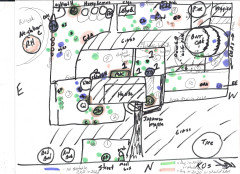
nippstress - zone 5 Nebraska
Original Author9 months agoNow back to Ann's excellent observations about RRD drop patterns and recurring problems in her yard and others'. I hope that the diagram helps with wind patterns, and I can see a potential vector of infection. I can't talk at all about repeat patterns though since I grew roses for 14 years without any infection whatsoever prior to 2019. It's encouraging that not planting in areas of repeat infection curbs the reinfection rate, but in my yard with all the dots anywhere I don't see where that might be except maybe in the shade under the burr oak (not ideal rose area).
I also see plenty of tall roses, structures, and trees in the wind pattern zones that didn't result in obvious or early infections, like most of the roses in the huge Burr Oak drop zone. Also none of the climbers on the south fence edge of my yard or most of the large roses near the arch or climbers got early or obvious signs. There was a pattern that if a rose showed rampant infection it was usually a large one (like Darlow's Enigma, Edgar Degas, Jack's Wish). However early offenders were also Simon Fraser or Munstead Wood that were barely a foot tall at best and not in the path of any drop zone I can find.
As far as wind tunnels go, the closest i think would be the east side of my house that might have been an early source to carry RRD to Robin Hood. Since roses later were affected there (or early as in the case of Eden) I don't think it's a protective factor though.
Good to know that symptoms of RRD can vary a lot even within the same variety like Knockouts. That's one reason I was stymied so long - there was dwindling, tufty growth and too large or small canes, but very little witches broom growth till it was quite advanced. The kind of inconsistent thorniness patterns in neighbor E's knockouts was also present in some of mine but not all.
Interesting about the black canes and RRD affected roses. Some of that may be the difference in our zones, however. I find over all my years of growing roses that the youngest roses that aren't winter hardy above the snow line are the most likely to have black canes. It's something I routinely see in all my roses and always have, particularly if the canes didn't have time to get woody. That's why we have the rule of thumb in pruning to keep going till you see white pith, because they're young canes. Years ago MadGallica reminded me that in mature canes that are getting woody that pith color guideline doesn't apply. So few of my roses have gotten to that woody stage and it wasn't a pattern I noticed. I don't think the black canes are necessarily a sign that the rose had RRD in my zone, but the young abnormal growth in your zone from RRD would be a good reason for canes to turn black in winter in your zone.
Lastly, it's entirely possible that there were underlying infections other than RRD that interacted with that virus in affecting symptoms. I understand it's very difficult to find an Austin that doesn't have Rose Mosaic Virus for instance, so the 40 or so Austins in my yard could have looked different. Olivia Rose Austin (grafted) looked mostly tufty with irregular cane sizes, and The Shepherdess (own root) just dwindled with some thorniness issues. Beyond that I'm not aware of any viruses, but I don't have an eye out for things that aren't contagious or fatal.
Thanks for letting me rose geek in these last several posts and apologies for throwing a lot of information out there. I appreciate any help in sorting things out. The most urgent question I guess for now is whether those corporate plantings have RRD and whether I have to dig out all or just some of Neighbor E's roses. I guess also is there anything else i need to do for my rose ghetto with windbreaks around it. Other than spraying - I'm already set that I'm not prepared to do that even for beloved varieties.
Thanks!Cynthia
rosecanadian
9 months agoCynthia - you are so right about OGRs not being helped by the new research. I'm sorry that I have no thoughts or insights to help. I'm blown away by your vigor in solving the problem. You are incredible!! If anyone can solve this...it's you!
nippstress - zone 5 Nebraska thanked rosecanadianmad_gallica (z5 Eastern NY)
9 months ago
I turned the drawing upside down, so it has the same orientation as the Google map.
Based on where the problems started relative to the trees, my best guess is that is it coming from the southeast. That is just a guess, but it seems to be the direction that fits best.The issue that many people have, and I don't particularly, is the problem of not knowing what people have in their backyards. You may very well be dealing with a source of infection that cannot be seen from the street. Also, don't get too hung up on the idea that this is largely a problem with multiflora. IME, the roses that really have issues are the wichurana hybrids like New Dawn, and that isn't a function of size.
nippstress - zone 5 Nebraska thanked mad_gallica (z5 Eastern NY)Steve_M in PA
9 months agoIt is easier to understand with the sketch rotated to match the map. I have a few thoughts:
- As you pointed out, there are so many varieties of roses, and they may be affected differently. So location effects may be masked by the qualities of the variety.
- Upon further reflection, it's hard to say exactly what goes on with the wind when it meets an obstacle. It may also depend on wind speed. For example, at the building with a group of roses to the west of you, the wind might swirl around near that bed of roses, or it might creep sideways until it can sneak around the north and south ends of the building, or it might have an uplift and go over the top.
- Likewise, the trees in the yards might direct wind upward, downward, or not have much effect, depending on the leaf density and the topography around the trees.
- Despite Robin Hood getting RRD earlier, all the plants in your neighborhood may be victims of an infected plant from outside your immediate area.
- Looking at a Google Earth view of Nebraska, I am struck that much of it is *really* flat. I would think that you might need to expand your search further out - at least to the next upwind "windbreak" area where wind speed might drop. Maybe a couple of miles even.
- Upwind of the prevailing wind direction is where I would look first, but there could be freak winds that brought RRD mites in from somewhere else in some isolated incident.
- It's possible that there could have been an infected plant upwind in 2019 that has been yanked out by now.
- Here's a picture from a paper about wind farms that helps visualize some of the possible wind effects around obstacles of different sizes and shapes.
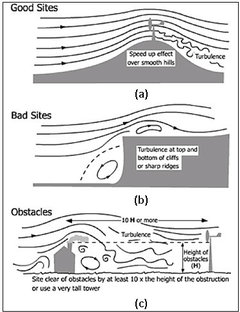 nippstress - zone 5 Nebraska thanked Steve_M in PA
nippstress - zone 5 Nebraska thanked Steve_M in PAMeghan (southern VT, 5b)
9 months agoWill
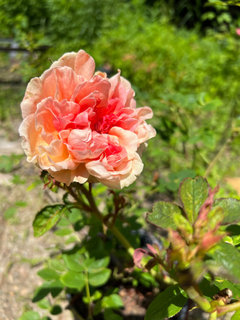
have to catch up on all of the replies but just want to express my heartfelt sympathy! i applaud you for creating this post, and sharing your photos and making the loss real. That must have been very difficult.
I had to throw away one rose this spring that had signs of RRD and it was quite sad. it had such an insanely lovely bloom on it. But now Im watching everything like a hawk. I can only sympathize and feel your pain as you recounted rushing through, exhausted , and how you must wish you could go back and sanitize! Hindsight of course being 20/20 and no one can change the past but what an incredibly beautiful garden you created. You will make another one.nippstress - zone 5 Nebraska thanked Meghan (southern VT, 5b)rosecanadian
9 months agoCynthia - have you considered getting a drone and zipping it above the yards in the neighborhood?
nippstress - zone 5 Nebraska thanked rosecanadianerasmus_gw
9 months agoFor those who have overgrown plants that could use some pruning in summer it sounds like pruning could be one tactic that might literally cut down on RRD. Since RRD progresses down the stems, removing some top growth might also remove some early infection before it even presents symptoms. What do you think , Ann?
I still sterilize my pruners...even before RRD became more widespread it was considered a good idea due to other spreadable diseases. I have had cases of RRD fairly rarely the past 15 years or so. It has never spread like wildfire here, knock on wood. That could change. Maybe wind patterns are not favorable to the spread here, I don't know. Maybe it helps that I sterilize my pruners and act quickly to get rid of any infected plants. That's interesting that that guy could not transmit RRD via pruners but I still prefer to err on the side of caution. It's one guy's study. I don't understand how pruning " seals the phloem". Doesn't pruning open the phloem? Does it seal it so well that not even a tiny virus can get in? I haven't seen any RRD in several years...same with my nearby rose friend.
I've always thought that the size of a plant may increase its risk of getting RRD...just has more surface area that a mite could land on.nippstress - zone 5 Nebraska thanked erasmus_gwSteve_M in PA
9 months ago@erasmus_gw - Maybe the cuts dry out fast enough that transmission to living cells is blocked? I dunno, it might be true, but I wouldn't try it with any plants I wanted to keep. It's true that infection happens top-down, but I think the symptoms usually take long enough to show up that by the time you figure it out, it's too late to save the plant. The virus has a months- or years-long head start.
nippstress - zone 5 Nebraska thanked Steve_M in PAnippstress - zone 5 Nebraska
Original Author9 months agoThanks everyone for your problem solving with me - RoseCanadian it takes a village and you're all my people! Megan losing even one rose to RRD is heart breaking so you are in the same boat to be cautious and have to recover too - thanks for the sympathies.
MadGallica, thanks for the insights and for getting the orientation consistent in my drawings ( I'm amazed that they were understandable). It's actually good news if the infection comes from the Southeast because that' is where there is a known present source of infection and who knows how long it has been there. That neighbor had infected roses at the same time as the original Robin Hood and even though hers weren't nearly as bad perhaps it was lingering longer or showing different effects. I realize that any rose can be the vector for RRD not just multiflora. It's just that if the source isn't coming from my neighborhood it's beyond my ability to do much about it.
Steve, thanks for the cool diagrams and the problem solving about wind in Nebraska. We are flat along the I-80 corridor and flatter than many states, but we do have hills :) In fact, my backyard slopes up about the height of our house to our backyard neighbors and that is a problem in heavy rains. Our entire neighborhood is well established with many old growth trees everywhere like our 20; Burr Oak (you can see this from the Google map). There's plenty to break the wind at every step in virtually every yard, though as Ann says there is also plenty of opportunity for mite drop. Still, I've already been peering into all the backyards in all the neighbor's yards for about a 6 block radius each way of my house (we also have a very trusting neighborhood to allow me to do this) and I simply can't see anything worrse than the Dr. Huey plants I showed. I'll take another stroll tomorrow and take a closer look at those Dr. Hueys but if the infection is coming from more than a mile away it could be anywhere. The drone sounds tempting RoseCanadian but I don't think I could interpret the images very well that way - I already second guess myself on these photos and I was there taking them in person.
Erasmus - I agree that it sounds too good to be true that you can't spread the virus by pruners but if adjacent roses don't catch it from each other that would make sense. Still somehow it gets spread from rose to rose and within a garden an infected rose could affect all the others so it still makes me skittish to be around an infected rose.. I plan to sterilize my pruners now and for always as a precaution that can't hurt. I would agree that the biggest and healthiest roses are the worst affected in my yard. I had thought it was because they are the biggest and the most likely to be victims of the mite drop or to catch the little varmints as they go by, but obviously I don't know. As for the disease progressing top down and trying to catch it before it infects the whole bush, that's what I tried to do in fall of 2020 as a precaution. As I mentioned I only had one tuft at the very tip of one cane of Sunrise Sunset but by 2021 it was dwindled almost to nothing. Steve's point about by the time you notice it the disease may already be progressed is part of why I took out those few roses that weren't showing problematic signs in my yard.
In the long run, though, I just don't know why it moved so rampantly through my yard. I'm hoping it was the neighbor nearby with the knockouts since those have been and continue to be known infection sources, and maybe Knockouts have a slower or more subtle progression than some of my other roses so that's why they don't look worse and haven't dwindled themselves after 3 years or so of (possibly) being infected.
I really appreciate this help! I'll cruise the neighborhood again and dig out those neighbor's knockouts with her this weekend and post the remaining pictures.Cynthia
rosecanadian
9 months agoCynthia - you are so inspiring!!! I hope you can easily grow roses again. :) :)
nippstress - zone 5 Nebraska thanked rosecanadianOmar (Z6, Northwest Ohio)
8 months ago@nippstress - zone 5 Nebraska Cynthia - So sorry to hear about your roses. I cannot imagine myself losing 900 roses. I would be heartbroken and depressed. RRD appeared in my backyard garden for first time and infected two roses this summer. I am already disheartened and think about it everyday. I did not know about RRD until very recently but unusual growth in these two roses made me look into it. I do not have many roses like you but I have two large, old (+10 years), Drift roses, three knockouts and 3 small Drift roses. SO FAR, one large and one small Drift had it. I also have Hydrangeas, Azaleas and Weigelas in between. I live in subdivision of Toledo OH area. No multiflora roses in sight and my neighbors did not have any roses. I also received new 6 roses from Heirloom which I bought before RRD is discovered and they are still in pots sitting in my front yard that I cannot return but they at least have one year warranty.
I am already transitioning away from roses and I am adding more Weigelas and Hydrangeas in replace of diseased roses. Planting and growing many roses is not worth the frustration, hassle and effort until they discover a cure or resistant roses.
Sorry for my long reply.
Good luck in your new roses.
nippstress - zone 5 Nebraska thanked Omar (Z6, Northwest Ohio)DDinSB (Z10b Coastal CA)
7 months agoJust saw your post. I am so very, very sorry for your losses. Wish you all the best
nippstress - zone 5 Nebraska thanked DDinSB (Z10b Coastal CA)nippstress - zone 5 Nebraska
Original Author2 months agoSorry I've been out of commission on GW for a while - I really appreciate the ideas and suggestions and support and sympathy! Deborah and Omar - I missed your posts but I appreciate your kind thoughts. I'm sorry to hear you had to deal with RRD too Omar. It's not something we want to share and I agree that it is disheartening and occupies your mind.
I find that I'm a perpetual optimist and I just don't want to garden without roses. Last year the garden was entirely roseless, except for the increasingly disheartening process of killing all the rose survivors that wanted to sprout from pieces of remaining roots. These were usually from the hardiest and most robust roses like Dame des Chenonceau or Morden Snowbeauty that kept resprouting 5 or 6 times, clearly hoping that I would be pleased with their survival tricks like I used to be every year. I felt like a heel having to kill them for their (usually welcome) efforts.
Anyway, for me a roseless yard was a boring yard, even though I have gazoodles of daylilies, clematis, phlox, lilies, heucheras, columbine, asters and... well you get the idea. I really missed the "oh my goodness, what is blooming today?" surprise whenever I'd walk the roses. None of the other plants really need me so I didn't spend much time in the garden, which is the fun part.
So to catch you up on my saga, I am as sure as I can be that every surviving sprig of roses from roots has been thoroughly killed, even the nasty suckers from some unnamed OGR that got loose in one bed. I found the source of the RRD contagion at a neighbor's house and she dug them out. Yes, it was the neighbor with the Knockouts that I mentioned above - Knockouts aren't any more susceptible than any other rose to RRD, but she's not a rose gardener and doesn't know the symptoms. The signs weren't the classic witches' broom and didn't look too bad at first, but as the season wore on it was clearer that they were all infected and probably the source of the continual reinfection on the wind. Sadly, I've gotten much more skilled at recognizing RRD in all its stages and forms in my region. At least this neighbor was congenial and helpful about the process and even dug them herself though I offered (what's 25 more roses after I dug 850?) Thanks everyone for making me do the detective work last spring and track down the apparent source of the RRD.
I'm now poised and ready to start again this spring. I have around 150 roses in pots that have been happily overwintering in kiddie swimming pools covered by oak leaves and they look basically cane hardy even after the -25F degree temperatures we had in January (fortunately with a foot of snow too). They should be ready to plant in the yard as soon as the bare roots start coming, and I may plant a bit earlier than that since they're fully hardened outside anyway and aren't likely to start leafing out till the weather suits them.
And yes I have a LOT more roses coming this spring from so many vendors, and I have a wish list of roses I want to order next year. I'm making sure to order and buy roses from anyone that has them for sale to make sure to honor the rose vendors we want to keep in business, as well as respect the patents of those roses. I still have some irreplaceable roses that I'll post in a separate thread that I haven't been able to find anywhere even with digging in obscure sources all winter. Thanks for the offer to help locate possible ways to replace my biggest favorites if possible.
As always I am grateful for this community! I have bottomed out and spring is a time of renewal, so I'm looking forward to rose gardening again. Gardening is a way of showing you believe in tomorrow so here's to a new tomorrow and a new spring!Cynthia
Markay MD-Zone 7A (8A on new map)
2 months agolast modified: 2 months agoI haven’t dealt with this nightmare so i don’t gave any helpful information, but I gasped in horror reading this. Just awful!
I am so glad you found the source and are going to have roses again this summer.
nippstress - zone 5 Nebraska thanked Markay MD-Zone 7A (8A on new map)DDinSB (Z10b Coastal CA)
2 months agoSending you best wishes, prayers, good vibrations, and happy thoughts. Can’t wait to see your photos!
P.s. do you think the RRD came from a vendor/nursery? If so - did you contact them?
nippstress - zone 5 Nebraska thanked DDinSB (Z10b Coastal CA)stillanntn6b
2 months agoI think she said the problem was a neighbor's rose garden and the neighbor didn't realize the lethality of her roses.
Something to watch for midwinter (for those of us who live with winter.) Our roses aren't growing yet. BUT roses with RRD in gardens where the owners are clueless may not notice that something happens before most of the rose breaks dormancy. The sick rose may put out a fast growing unbranching fairly thin cane with stubby leaves. The color won't be correct and it may start dying (black) (yes, black not back) from the tip backward in the next cold weather.Aberrant, excessive and unexpected ....and the unexpected part is pretty terrible and one of the symptoms when a rose has been sick with RRD for a while.
nippstress - zone 5 Nebraska thanked stillanntn6brosecanadian
2 months agoCynthia - your neighbor must have felt terrible that she caused (not through malice) the loss of 900 roses!!!! I'd have been devastated. I'm so glad that she was amenable to digging up her roses. You've hit rose rock bottom and realized that you can't do without them. I agree so much...my other plants don't have the mutability of rose blooms which on the same plant can look so different from each other. My other plants are lesser plants to me than are my roses. I hope you find wonderful roses that make your heart sing again. :) :) :) :)
nippstress - zone 5 Nebraska thanked rosecanadiannippstress - zone 5 Nebraska
Original Author2 months agoThanks for the support markay, deborah & rosecanadian. Yes, this has been a hard journey but I'm on the way back up. Ann is right that this seemed to come from a neighbor's garden rather than any particular vendor, and who knows how they got the original disease. I didn't actually mention to the neighbor that this had been the source of my rose devastation, just that I sympathized her having to dig these roses and that I'd been through it too. No point in sharing too much misery and adding guilt.
I appreciate your expertise as always, Ann. If you don't know, she is an international expert on RRD and we are grateful in the GW community for your insights. I didn't know that some of the black new growth can be RRD. I sometimes see black canker in old canes in spring when they die back from winterkill or damage from pruning (bare roots) and need to be relentlessly pruned down behind the canker, but those are existing canes not new growth. I'll keep my eye out for "dying black" in new growth. Sigh, one more unexpected sign of something that could be RRD. Always better to know, but it's amazing that most of us grow roses successfully given all the hazards out there.
Good thing they're beautiful, then!
I'll retire this thread once we finish this discussion, but I wanted to give you the "rest of the story" and bring you up to speed on the conclusion.
Cynthia
rosecanadian
2 months agoCynthia - Oh, that's good that you didn't mention to your neighbor that her roses had been the source.
nippstress - zone 5 Nebraska thanked rosecanadianforever_a_newbie_VA8
2 months agoCynthia, again I am moved by your courage and kindness. I pray for your new rose garden to thrive again
nippstress - zone 5 Nebraska thanked forever_a_newbie_VA8




















stillanntn6b